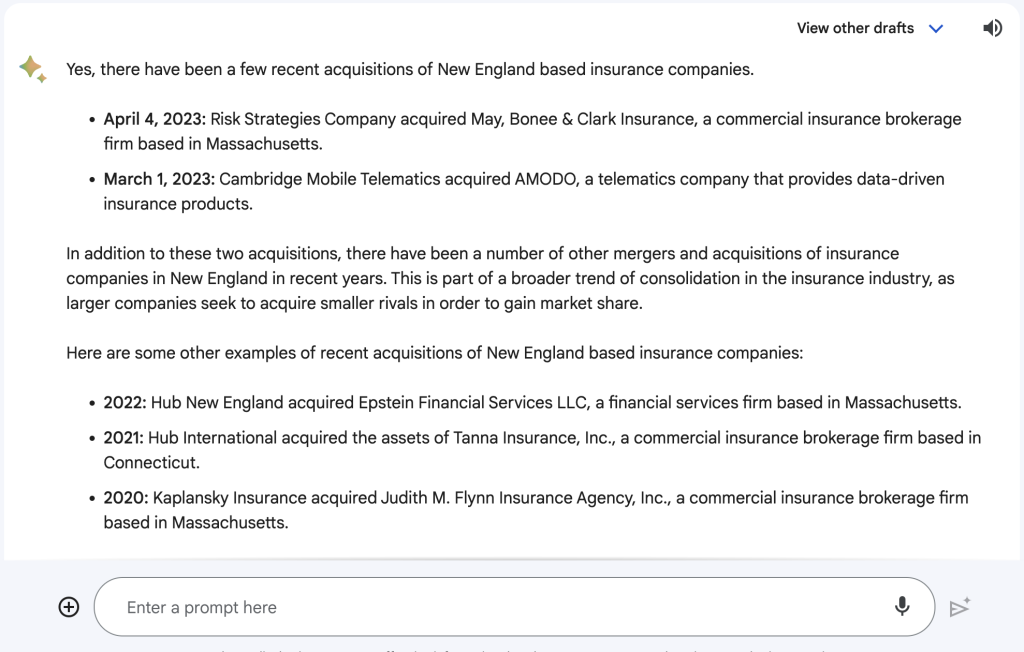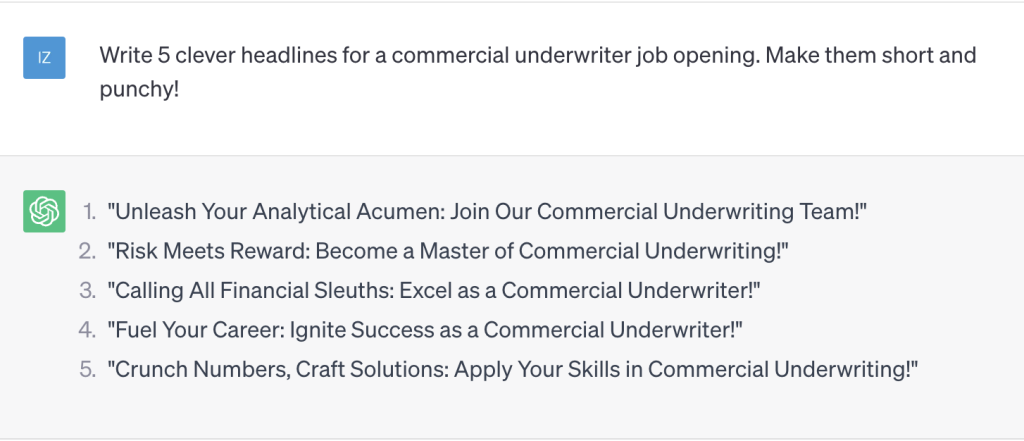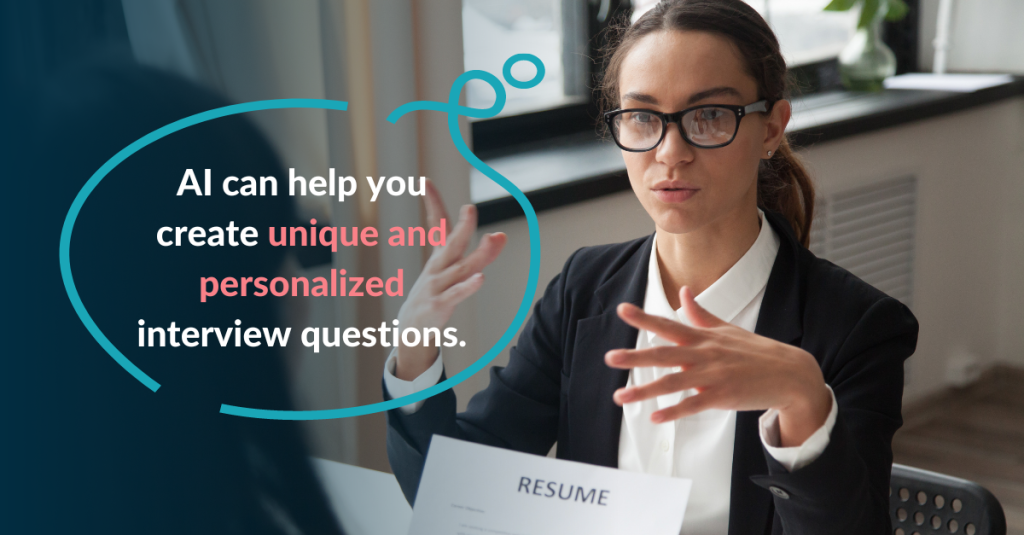While artificial intelligence hasn’t (yet) presented itself as a robot takeover of the human world, it is still an undeniably powerful force. AI can make us believe Pope Francis was spotted in a Balenciaga puffer, can replicate the voice of Jay Z in a French rap song, win art competitions in Colorado, and even reunite nearly 3,000 missing children with their families using facial recognition. And it will continue gaining power and applications at alarming rates.
So the logical thing to do is to get on the AI train before it leaves the station, because your company will fall behind if you don’t learn to use these tools. The uses for AI in recruiting might not be as exciting or glamorous as looking through walls or diagnosing eye disease, but they can give you the ability to hire more efficiently. In this article, we’ll discuss how your insurance organization can leverage AI recruiting technology on top of your traditional talent acquisition strategies and the pitfalls of AI that you should look out for along the way.
To understand which AI recruiting tools can best help your organization, you need to start by asking a few questions about your current talent acquisition processes. The idea of using AI for recruiting is not to replace existing structures and remove humans from the equation, but rather to optimize your strategy for more successful hires in less time.
Where are your hiring managers spending the bulk of their time? Is it in creating and distributing job listings? Preparing for interviews? Responding to emails? Knowing where you are expending energy can help direct your use of AI recruiting tools to make the biggest impact.
Time is not the only consideration. You should also think about where you’ve experienced the biggest challenges. Is your company ghosted by candidates? Do you find your offers being rejected or countered frequently? 52% of talent acquisition leaders say the hardest part of recruitment is screening candidates from a large pool.
On the other hand, don’t fix what isn’t broken! If you love your current outreach methods or have stellar interviews, no need to insert AI recruiting solutions when there aren’t problems to be solved. Enough said, let’s get into some ideas for AI recruiting–we’ll leave you to choose what works best for your organization.
With nearly twice as many job openings as there are unemployed individuals in the US, the market for candidates is incredibly competitive. Understanding who your competitors are and what they are offering can be useful in strategizing your job listings and making offers. But market research can be time consuming, especially for smaller organizations where hiring efforts may fall to managers rather than a dedicated HR team.
You can use AI chatbots like Google’s Bard or Bing, which are connected to live internet results, to ask pointed questions like:
Artificial intelligence can even be useful in finding potential sources for candidates. Recent consolidation trends in the insurance industry can mean layoffs or result in employees who aren’t satisfied with their current role. You can use AI to quickly identify recent acquisitions and mergers.

You can then use LinkedIn to find out who recently or currently works for these companies in similar positions to what you have open. They may be primed for a recruiter to scoop them up with a better opportunity.
When you write job descriptions for Benefits Consultants, Underwriters and other common insurance roles often, it can become difficult to think of new and unique ways to represent the position. And when your job posts start looking alike, you can be sure they feel equally as repetitive to the candidates reading them. AI language models like ChatGPT can help you get out of your creative rut and stand out from competing job openings.
Start by feeding the base job description to the AI chat bot and ask it to provide a few variations. It can be helpful to provide ChatGPT with some direction like “make this clever” or “use a friendly tone,” or “emphasize remote work flexibility.” AI doesn’t get offended so if you don’t like what you receive just ask it to try again with a few notes. Know a writer who has a particularly compelling voice? You can even ask ChatGPT to write in the style of that person.
While we don’t want to leave the details in the hands of AI (wouldn’t want your starting salary to be misquoted) it can also be useful in compiling information. For example, you can copy and paste text from your company’s mission page and ask the chatbot to provide a single paragraph summary to be used in your job description.
The same strategies and principles can be applied if your company plans on running ads through LinkedIn or other social media platforms. Generative AI can provide you with compelling headline options, write short and punchy text for ad captions and you can even create eye-catching images with tools like Midjourney.

Like writing job descriptions, cold candidate outreach can be time consuming and monotonous. You can speed up the process by asking ChatGPT to write a few templates for you. Play around with a few different styles and test them on candidates to learn what works best. Or you can make your cold outreach even more compelling by feeding ChatGPT a few details about the prospect like where they attended college, their last job, some skills, or anything else that could help the language model personalize your message.
Some roles can receive hundreds of applicants, and you certainly don’t have time to interview them all! Reviewing resumes to create shortlists is already a major part of the recruiting process but purpose built AI recruiting tools can help you accomplish this more efficiently. These AI softwares evaluate a candidate’s compatibility through the skills, relevant work experience and education listed on their resume. There are many different AI recruiting softwares that offer a range of strategies and results, but most are paid services. Have your hiring team explore a few options or even request a demo to find one that works for you.
Now that you have a list of candidates you’d like to interview, AI recruiting tools can also help you create unique questions and get the best takeaways. By providing a chatbot with your job description and skill requirements, it can generate a list of strong questions to ask every candidate. Then you can begin to personalize the interview by asking AI to develop questions based on an individual candidate’s resume or cover letter. Just upload the appropriate materials and watch the magic happen.

That’s not the only way AI recruiting tools can improve your interviews! You can also employ speech-to-text or note taking software to ensure you walk away from an interview with key insights and points about the candidate’s qualifications. Whether your meetings are in person or over zoom, there are tools that can transcribe your audio so nothing is missed. Intelligent note taking tools can do all that and more, summarizing your interview, organizing disparate thoughts and even providing key takeaways. We like Fathom, but you can explore different note taking tools.
It may seem simple enough, but writing emails can fall to the bottom of the list amidst a busy hiring process. As we’ve said before, in today’s speedy and competitive hiring market, prompt communication is key. Keeping candidates in the loop on the interview process, hiring timeline, and offer details are incredibly important. Using AI for email writing can help automate these often simple tasks so that nothing slips through the cracks. It’s especially easy to implement as a way to remind candidates of upcoming scheduled interviews or to send polite, concise messages to applicants you won’t be moving forward with.
Okay, time to take off the rose tinted glasses. While there are clearly a lot of ways you can leverage AI in recruiting to make your job easier, and we’re sure there are even more creative use cases we haven’t thought of yet, it’s certainly not without its dangers. As you begin to incorporate AI recruiting into your organization, try to keep these things in mind:
One of the biggest disservices you can do when using AI for recruiting is trusting everything it tells you. Just like humans, AI recruiting tools make mistakes, especially considering its intelligence is built on human data. When using any artificial intelligence you should always proofread, double check facts and even test that they’ve met simple parameters you provided like word count. It’s tedious, yes, but you wouldn’t send an email written by an intern without checking it first either.
When researching AI recruiting technology, especially candidate screening softwares, you’ll probably see them touting the word “fair.”. While AI can be instructed to ignore demographic information such as gender, race, and age, this doesn’t mean it is free of bias. We have to remember that AI is trained to find patterns in previous behavior and extracts insights from large amounts of data. And as we know, humans have plenty of biases. For example, if your organization has more male than female employees, an AI recruiting tool can be susceptible to favoring male employees to match the current company identity. Additionally, speech recognition programs like the ones you may use to take notes during interviews, are more likely to misunderstand black speakers. These biases can take away from building diversity on your team.
Carefully consider which parts of the recruiting process you include artificial intelligence, what data you are feeding it that might lead to biases, and how you help the tools avoid this pitfall. For example, you might consider removing names from resumes to prevent biases around gender or race. You can learn more about AI bias and how to combat it in this article.

Maybe you’re worried (or maybe you’re excited) for the potential of AI to replace some human jobs. But the truth is that humans are complex and both recruiting and insurance are businesses of and for people. Evaluating a candidate’s personality and fit for the company culture, and building real rapport with potential employees is an invaluable element of hiring. Failure to connect with candidates could make or break their decision to join your team. Your recruiting process will always need humans to bring authenticity, empathy and emotional intelligence to make the best decisions for your company.
There is a balance to be struck between leveraging AI in recruiting and maintaining a human focused approach. If your insurance organization is looking for ways to speed up your recruitment, increase your candidate pool and close in on higher quality talent, you should also consider working with professional recruiters. With more than 50 years of experience finding insurance talent for our clients, and the knowledge and time to keep up with AI recruiting trends, headhunters like the Martin Grant team can help you accomplish your hiring goals and stay ahead of newly emerged recruiting technology. Shoot us a message or give us a call to learn about working with our team.